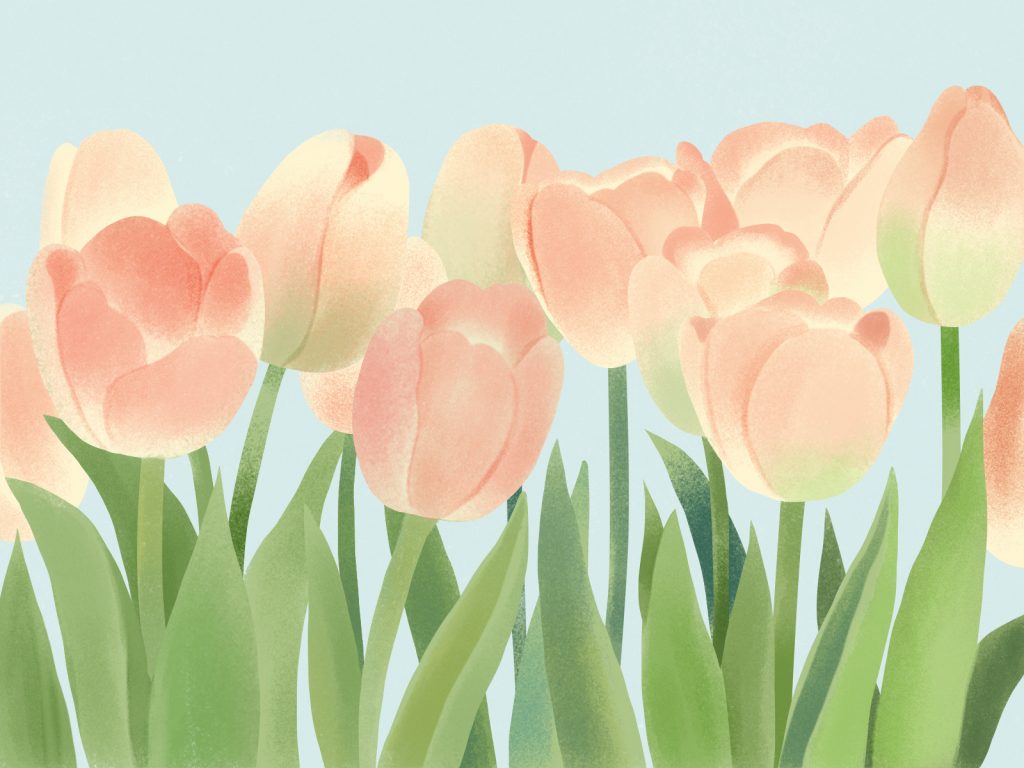“Lightness” is a virtue in haiku. The deeper the poem, the more likely it is to seem like nothing special. An observation made in passing. A moment of reflection that at first seems only playful but on second thought might just be profound. The winning and honorable mention poems for last month’s challenge read as spontaneous utterances, even if the poets may have labored to achieve that effect.
- Renee Cassese offers a portrait in miniature of a world beyond suffering in her description of a tulip “tilting in the wind.”
- Judith Lavelle’s neighbor uses the language of flowers to send a simple message: “this week, it is spring.”
- Nancy Winkler welcomes the yearly return of “bright yellow tulips” bearing news from the mycelial underworld.
Congratulations to all! To read additional poems of merit from recent months, visit our Tricycle Haiku Challenge group on Facebook.
You can submit a haiku for the current challenge here.
Spring Season Word: Tulip
WINNER:
life is a tulip
opened to the elements
tilting in the wind
— Renee Cassese
According to Buddhist tradition, once when Shakyamuni’s disciples had gathered to hear him preach on Vulture Peak, he held up a flower. And that was all. The complete sutra. Even without any words.
The story dates from the early 11th century and belongs to the tradition of Chan Buddhism, where it might be said to represent the final, perfectly compressed form of the prajnaparamita (“Perfection of Wisdom”) teachings. The largest prajnaparamita sutra is 100,000 lines long, while the shortest—The Blessed Perfection of Wisdom, the Mother of All the Tathagatas—consists only of the letter “A,” the first primordial sound.
Whoever wrote the “Flower Sermon” seems to have gone one step further. The whole canon is reduced to a pantomime as the teachings come full circle, bottoming out in the natural world.
But the flower is not a substitute for words. Not a symbol, in other words, but something altogether beyond our human frame of reference. It is, to borrow an expression from my daughter and fellow author Sophie Strand, a manifestation of “The Animate Everything.” It includes humans but is more than human. In ecological terms, it is the “beyond” to which the teachings point.
Fortunately for us, the beyond turns out to be right here. The secret is visible because we are a part of it. Everything is related. Nothing is hidden. Like the flower the Buddha held up for his disciples, it is there for all to see.
The winning haiku for our March 2024 Haiku Challenge reads like a seventeen-syllable expansion on the “Flower Sermon”. The opening line echoes Shakyamuni’s first teaching, “Life is suffering,” but steps deftly past it into a realm where suffering has no hold. The flower is “opened to the elements” because it is not at war with the elements but accepts the blessings or challenges of each moment as it comes.
The final line continues in that vein with its image of the tulip bending slightly in the wind. But the word “tilting” calls a head to mind, or even the Earth nodding on its axis in its yearly orbit around the sun. The word gives the flower a poised, somewhat thoughtful demeanor that follows through on the surprising, almost shocking assertion “life is a tulip.”
The tulip bears the truth of that assertion lightly, even effortlessly. It may not be a human being, but it is a being nevertheless—alive and sentient in a way that only a poet (or a Buddha) can understand.
HONORABLE MENTIONS:
without her tulips
how would my neighbor tell me?
this week, it is spring
— Judith Lavelle
they briefly surface
to share what they’ve been up to
bright yellow tulips
— Nancy Winkler
♦
You can find more on March’s season word, as well as relevant haiku tips, in last month’s challenge below:
Spring season word: “Tulip”
tulip bulbs are proof
that if you love a color
you should bury it
Submit as many haiku as you wish that include the season word “tulip.” Your poems must be written in three lines of 5, 7, and 5 syllables, respectively, and should focus on a single moment of time happening now.
Be straightforward in your description and try to limit your subject matter. Haiku are nearly always better when they don’t have too many ideas or images. So make your focus the season word* and try to stay close to that.
*REMEMBER: To qualify for the challenge, your haiku must be written in 5-7-5 syllables and include the word “tulip.”
Haiku Tip: Write haiku as a form of popular literature!
As an artform, haiku is not as monolithic as most Western readers suppose. Even Japanese traffic slogans are often written in 5-7-5. The same with jokes, advertising jingles, and public service announcements. And this is nothing new. Arrangements of 5-7-5 syllables are pervasive in Japanese culture and always have been.
In the premodern age, this gave rise to the first popular poetic pastime in world literature. One person would contribute a poem written in 5-7-5 syllables, the other a 7-7 syllable verse to complete, or “cap,” that poem. Or sometimes the order would be reversed.
The practice of “verse capping” goes back 1,300 years to the Kojiki (“Record of Ancient Matters”), the first book ever published in Japan. But the poets included in that anthology, which privileged the culture of the nobility, were hardly representative of Japan as a whole. This changed with the advent of printing and mass-reproduction. By the 17th century, Japan could boast the highest level of literacy in the world.
With so many more people suddenly able to read and write, verse capping games became incredibly popular. A local referee (usually a poet of some note) would issue a challenge written in lines of 7-7 syllables, and participants from all walks of life would submit 5-7-5 syllable caps for judging.
These 17-syllable caps ran such a broad gamut in terms of quality and content that it is hard to know how to categorize them today. Verses could be sublime, profound, witty, funny, satirical, dirty, or even scandalous. Kobayashi Issa (1763-1828) cut his teeth on 17-syllable poetry as a verse capping referee during his years in Tokyo, and it was probably this experience that accounts for the down-to-earth quality of his haiku.
One can understand why Masaoka Shiki (1867-1902) wanted to dismiss the older, more freewheeling style of 17 syllable verse in his effort to establish haiku as a serious modern artform. But in so doing Shiki and his followers restricted the scope of 17-syllable versification, imposing rules that poets of previous centuries would never have understood the logic for, much less observed.
There are now upwards of 10 million active haiku poets in Japan, plus millions more writing in other languages around the globe. Although there are still some who believe, along with Shiki, that the goal of haiku is “the objective description of nature,” many write haiku as a form of popular literature, incorporating elements of ordinary speech, slang, humor, and topical culture to give their poems accessibility and mass appeal.
We are following that older verse capping tradition in our Tricycle Haiku Challenges, using season words instead of 7-7 syllable phrases as prompts. The use of seasonal themes provides us with a vital connection to the haiku tradition, while still allowing for a broad range of self-expression.
For the rest, we favor the older, premodern approach that sees the 5-7-5 form as a game-like invitation to expansive poetic play. At its most basic, a haiku is whatever you can get away with in 17 syllables. That is the only “rule” that holds true across the entire history of haiku.
A note on tulips: This month’s season word belongs to the “Plants” category for spring. A member of the lily family, tulips grow wild over much of Southern Europe and Central Asia. They were first cultivated in the 1oth century (probably in Persia) and by the 1400’s were among the most prized, and most expensive, flowers in the world. Tulips bloom in the springtime in a variety of bright colors—including red, orange, pink, yellow, or white. They go dormant from summer to early spring, at which time their bulbs begin to send up shoots. The Netherlands (the country most often associated with tulips) continues to be the world’s top producer of these flowers, exporting as many as 3 billion bulbs annually to other countries around the world.
Thank you for subscribing to Tricycle! As a nonprofit, we depend on readers like you to keep Buddhist teachings and practices widely available.

